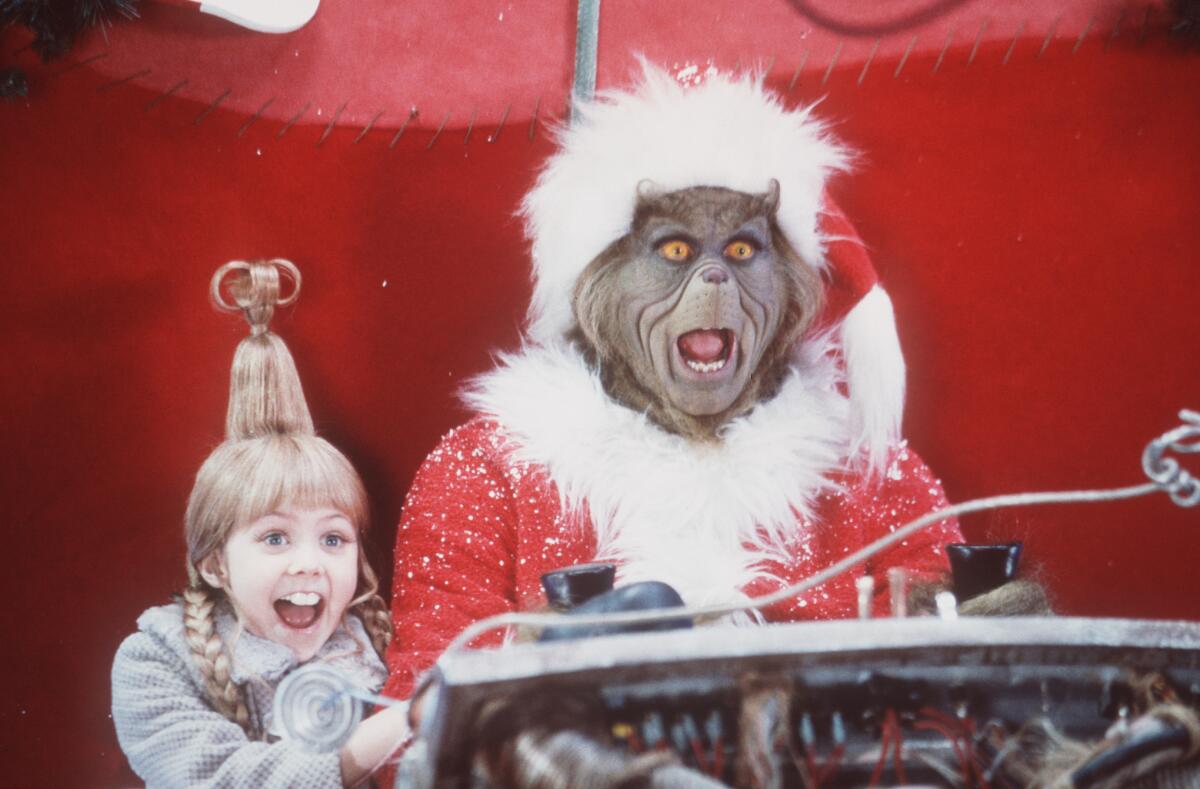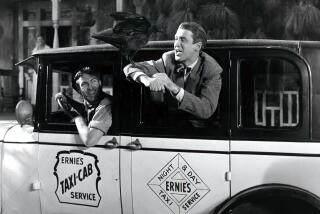From the Archives: Who(ville) Let the Grinch Out

“Dr. Seuss’ How the Grinch Stole Christmas” is one overstuffed movie, but it’s by no means a turkey. Yes, it’s odd to see a $100-million-plus extravaganza that mocks materialism and extols simplicity. Yes, the film’s frenetic attempts to create a full-length feature film out of a slender, albeit beloved, children’s book can be exhausting. Finally, however, the lively and amiable spirit of the endeavor converts our inner curmudgeon just as the spirit of Christmas eventually overpowered that larcenous Grinch.
A major holiday presence since it was published in 1957, so popular it’s even sold 24,000 copies in Latin (under the title “Quomodo Invividosulus nomine Grinchus Christi natalem abrogaverit”), “Grinch” has also been successful as a 1966 Boris Karloff-narrated Chuck Jones animated featurette.
But that made-for-TV item lasted less than 30 minutes, and achieving good results at close to two hours seemed an almost impossible task. Making that stretch possible was what turned out to be a delicate balancing act between four powerful forces that could have clashed but ended up in harmony: Ron Howard’s balanced direction, a cheerful and inviting look guided by production designer Michael Corenblith and visual effects supervisor Kevin Mack, Jeffrey Price & Peter S. Seaman’s clever script ideas and, the sine qua non, Jim Carrey as the Grinch.
In a part he seems almost predestined to play, Carrey uses his unequaled physicality and a face so mobile it seems computer-generated to turn the grumpy green monster into an antic combination of Chewbacca and Jerry Lewis. Holed up in a lair on Mt. Crumpit that’s part Bat Cave, part an especially messy teenager’s room, this character comes alive not as a person but as a creature, someone capable of treating his dog Max as an equal and, in a voice that’s part Karloff, part W.C. Fields and part Sean Connery, arguing violently with a sassy echo.
Though Carrey has called the 92 days he spent in the hand-dyed, yak-fur Grinch suit designed by Rick Baker “like being buried alive on a daily basis,” the remarkable thing about his performance is that you’d never know it. No amount of makeup can mask or hinder the actor’s ability to make crazy faces, and if he seems too much in overdrive from time to time, that’s just the way it has to be.
Just as arresting visually is the village of Whoville, which, despite verging on being over-designed, manages to come off as a playful, old-fashioned toyshop of a town whose almost but not quite human residents say “what the hey” and where everyone really, really, really loves Christmas.
Think of Mayberry on an insulin drip, think of a Disneyland that makes the Anaheim one look restrained, and you’ll have an idea of what 52,000 Christmas lights, 8,200 ornaments, 1,938 candy canes and more than five miles of electrical wire can accomplish when joined to a wacky architectural spirit that production designer Corenblith says was inspired by the personal design interests of Seuss’ alter ego, Theodor Geisel.
Without insider knowledge, it’s hard to say whether the production team or the scriptwriters came up with some of the niftiest features of Whoville, like a “Dumpit to Crumpit” garbage chute that the Grinch uses as an expressway to town, and the stamp the Whoville post office puts on packages that need to be expedited: “Heckuvarush.”
These touches indicate the cleverness with which writers Price and Seaman (who both also worked on “Who Framed Roger Rabbit”) approached the task of fleshing out the original Seuss narrative, which now takes up roughly the second half of the film. They’ve expanded the roles of characters already in the book, like Max the dog and Cindy Lou, the curious little girl, and they’ve come up with an amusing back story detailing why, in addition to having a heart two sizes too small, the Grinch has such an animus toward Christmas.
Smoothly narrated by Anthony Hopkins, “Grinch” focuses on Cindy Lou Who (the feature debut for an appropriately earnest 7-year-old Taylor Momsen), a determined young person who is troubled by Whoville’s Christmas commercialism and has just a suspicion that maybe Mr. Grinch, as she calls him, might not be such a bad person after all.
Doing her research, Cindy Lou discovers that the Grinch, Whoville mayor May Who (Jeffrey Tambor) and town heartthrob Martha May Whovier (Christine Baranski) were once classmates involved in a romantic triangle that did not end well. Can the Grinch, who still keeps a mailbox in town despite his Mt. Crumpit residence, be reintegrated into Whoville society? One thing for sure, it won’t be easy.
Riding herd on all this commotion is director Howard, whose innate earnestness as a director not only matches Cindy Lou’s but also turns out to be the perfect attitude when paired with the script’s wackiness and Carrey’s mania. With anyone less sane in charge, this “Grinch” might have tilted too much in unfortunate directions.
Still, even this “Grinch” can wear on you from time to time, as it either runs out of things to do or stops dead to listen to one of its several underwhelming songs. And there are moments when Seuss’ philosophy (“Maybe Christmas doesn’t come from a store. Maybe Christmas . . . perhaps . . . means a little bit more!”) threatens to get buried under all those visual gimcracks.
But on the other hand, “Grinch” wears its virtues lightly, and its dearth of gross-out material is remarkable both for a Carrey vehicle and for young-skewed films in general. “That ‘American Pie’ stuff,” Audrey Geisel, the author’s widow, who had script approval, told Entertainment Weekly, “has no place in Seuss.” That counts for a lot, especially at this time of year.
MPAA rating: PG, for some crude humor. Times guidelines: a few mild off-color gags and a frenetic pace that may be a bit much for the youngest viewers.
‘Dr. Seuss’ How the Grinch Stole Christmas’
Jim Carrey: The Grinch
Jeffrey Tambor: May Who
Christine Baranski: Martha May Whovier
Bill Irwin: Lou Lou Who
Molly Shannon: Betty Lou Who
Taylor Momsen: Cindy Lou Who
Anthony Hopkins: Narrator
A Universal Pictures and Imagine Entertainment presentation, a Brian Grazer production, released by Universal Pictures. Director Ron Howard. Producers Brian Grazer, Ron Howard. Executive producer Todd Hallowell. Screenplay Jeffrey Price & Peter S. Seaman, based on the book by Dr. Seuss. Cinematographer Don Peterman. Editor Dan Hanley, Mike Hill. Costumes Rita Ryack. Music James Horner. Production design Michael Corenblith. Art director Lauren Polizzi. Set decorator Merideth Boswell. Running time: 1 hour, 42 minutes.
More to Read
Only good movies
Get the Indie Focus newsletter, Mark Olsen's weekly guide to the world of cinema.
You may occasionally receive promotional content from the Los Angeles Times.











